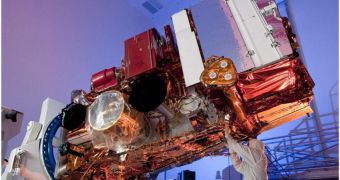NASA and the US National Oceanic and Atmospheric Administration (NOAA) have just awarded a new contract to Azusa, California-based Northrop Grumman Systems Corporation, for the development of an advanced instrument that will go on the first Joint Polar Satellite System (JPSS-1) satellite.
Northrop now benefits from the full support of the two agencies in designing, building, testing and delivering the Advanced Technology Microwave Sounder (ATMS) instrument, which will be a part of the remarkable suite of scientific instruments that will go on the JPSS-1.
According to initial estimates, the contract is worth about $30 million, and runs until 2017. During this time, the corporation must complete and test the instrument, while also providing the necessary logistics support for integrating it with the satellite bus.
The terms also state that the company must also provide launch and post-launch support for this next-generation, cross-track microwave sounder. The instrument is a melange of current capabilities, derived from microwave temperature sounders currently aboard NPOESS satellites.
Under the JPSS program, a constellation of new spacecraft will provide NOAA, NASA, and other civilian agencies with climate and weather forecast data, to be used for a wide array of applications.
At first, NOAA planned to build and deploy the National Polar-orbiting Operational Environmental Satellite System (NPOESS), but several issues prevented that. JPSS is the restructured, civilian portion of the larger project, which received the go-ahead following complex reviews.
The NPOESS Preparatory Project (NPP) satellite is now scheduled to launch in October, carrying the first flight model of the ATMS instrument. The device was completed back in 2005, so Northrop must now create the second flight model, to fly on the JPSS-1 spacecraft in 2016.
“The successful contract transition is an important milestone for the Joint Polar Satellite Systems, since ATMS is one of its key operational weather sensors,” explains the vice president of the Overhead Persistent Infrared and Azusa Programs business unit at Northrop, Dr. Steve Toner.
“The Flight 2 development, build and test have proceeded smoothly and follow the success of the Flight 1 instrument for NPOESS Preparatory Project,” the company official adds further. He says that ATMS' 22 channels will cover the frequency band from 23.8 GHz to 183.3 GHz.
“Our experience in creating the ATMS engineering development unit and delivering the NPOESS Preparatory Project flight unit showed our capability to support the customer,” Northrop Grumman ATMS project manager Steve Opel adds.
“This transition of the second flight unit to the Joint Polar Satellite Systems not only capitalizes fully on that previous experience, but also demonstrates our commitment to developing a long-term partnership with both NASA and NOAA on this program,” he concludes.

 14 DAY TRIAL //
14 DAY TRIAL //